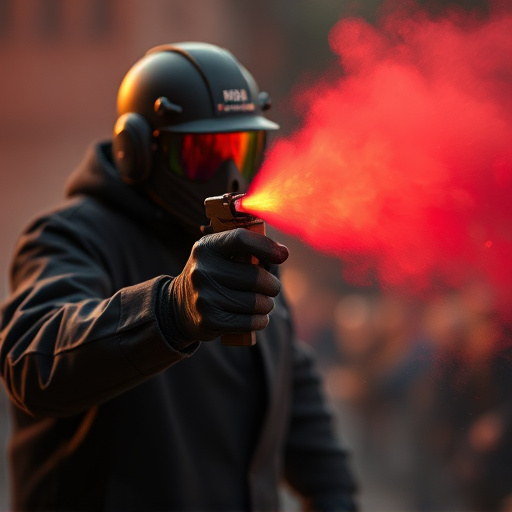Pepper spray, an anti-assault tool using capsaicin from chili peppers, temporarily disables attackers by causing severe irritation. Effective usage requires adhering to the Pepper Spray Eye Washing Procedure after exposure: close eyes immediately, protect face, and wash thoroughly with water for 15 minutes. In case of assault, create distance, flush both eyes simultaneously for 15+ minutes, and seek medical attention post-exposure. Responsible carrying and understanding local regulations, including the eye washing procedure, are crucial for personal safety and legal compliance when using pepper spray for self-defense.
“Discover the power of self-defense with anti-assault pepper spray—a non-lethal tool designed to disrupt and deter attackers. This comprehensive guide explores the essential aspects of staying safe. We delve into the science behind pepper spray, its composition, and why it’s an effective defense mechanism. Learn the critical eye-washing procedure to protect your vision during attacks. From legal considerations to responsible carrying techniques, this article equips you with knowledge to navigate self-defense strategies, ensuring both safety and legality.”
- Understanding Pepper Spray: Its Composition and Effectiveness
- Eye Washing Procedure: Protecting Your Vision During an Attack
- Carrying and Using Anti-Assault Pepper Spray Responsibly
- Legal Considerations: Rights and Regulations Regarding Pepper Spray Self-Defense
Understanding Pepper Spray: Its Composition and Effectiveness
Pepper spray, an anti-assault defense tool, is a compound designed to temporarily incapacitate an attacker by causing severe irritation and pain in the eyes, nose, and throat. Its active ingredient is capsaicin, derived from chili peppers, which triggers nerve signals that lead to these intense physiological responses. When deployed, pepper spray creates a burning sensation and reduces visibility, providing users with crucial seconds to escape or seek help.
The effectiveness of pepper spray relies on proper usage and understanding. Following the recommended Pepper Spray Eye Washing Procedure is essential after exposure. This includes immediate eye closure, face protection, and thorough washing of affected areas with water for at least 15 minutes. Prompt action mitigates discomfort and ensures the rapid dissipation of effects, allowing individuals to regain their senses and mobility.
Eye Washing Procedure: Protecting Your Vision During an Attack
In the event of an assault, one of the most vulnerable areas of your body is your eyes. Pepper spray, while effective in deterring attackers, can cause severe irritation and damage to the eyes if not handled properly. The first step in a pepper spray eye washing procedure is to immediately seek shelter or create distance from the attacker to avoid further exposure to the irritant.
To begin the eye washing process, use clean water—from a safe source like a nearby faucet or bottled water—to thoroughly flush both eyes simultaneously. Hold your eyelids open and pour or splash water over your face, making sure to get the water into the corners of your eyes and under your eyebrows. Continue this for at least 15 minutes to dilute and wash away the pepper spray chemicals. If possible, seek medical attention afterward to ensure there is no lasting damage.
Carrying and Using Anti-Assault Pepper Spray Responsibly
Carrying anti-assault pepper spray responsibly is paramount for personal safety and legal compliance. Always keep it in a readily accessible yet discreet location, following local regulations regarding storage and transport. Understand that pepper spray is designed as a non-lethal force tool, intended to temporarily disable an attacker, allowing you to escape or seek help.
Using pepper spray requires careful consideration and proper technique. In case of an encounter, aim for the face, specifically the eyes, nose, and mouth, where it will cause severe irritation. Follow the instructions provided with your spray, as different models may have slightly varied procedures. After deployment, quickly move to a safe distance, ensuring you don’t inhale the spray yourself. Remember, proper eye washing procedure is crucial if pepper spray makes contact with your eyes, and seeking medical attention afterward is recommended.
Legal Considerations: Rights and Regulations Regarding Pepper Spray Self-Defense
When considering pepper spray as a self-defense tool, it’s crucial to understand the legal considerations and rights that come into play. The use of pepper spray for self-defense is regulated by state laws, which vary widely across different jurisdictions. In many places, individuals have the right to protect themselves with non-lethal force, including pepper spray, if they reasonably believe they are in danger. However, there are strict rules regarding where and how it can be carried, as well as the specific circumstances under which its use is permitted.
One critical aspect to keep in mind is the Pepper Spray Eye Washing Procedure. While pepper spray is designed to temporarily incapacitate an assailant by irritating the eyes and respiratory system, it’s essential to follow recommended safety protocols. This includes ensuring that you have a clear understanding of when and how to deploy the spray, as well as taking steps to minimize its impact on bystanders or yourself after use. Knowledge of local regulations and proper procedure can help ensure that your right to self-defense is protected while adhering to legal boundaries.
Pepper spray, as a powerful self-defense tool, offers individuals an additional layer of protection against potential assaults. Understanding its composition, learning the correct eye washing procedure, and knowing legal considerations are essential steps to carry and use pepper spray responsibly. By equipping oneself with this knowledge, folks can confidently navigate their safety in today’s world, ensuring they have a game-changer in their defense arsenal. Remember that staying informed and prepared is key to fostering personal security.
